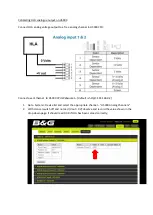
35
3. Loosen the jam nut securing each of the four belt tensioning
bolts (on both sides, front and rear); then loosen the
adjusting bolts.
4. Pull the belt to the rear and remove the rear roller; then
pull the belt forward and remove the front roller.
5. Remove the diamond wiper located in the center of the
hopper.
Note: The diamond wiper is located between the
frame of the machine under the fender. It is mounted
with the UHMW plastic facing downward.
6. Remove the bolts holding the belt run in place.
7. Set two sawhorses in front of the hopper and pull the belt
and belt run out together. If it seems tight, the belt may
be removed from the front as well.
8. Roll the belt run over on its side and remove the old belt
from the belt run.
9. Slide the new belt over the belt run. Make sure the cups
on the belt will face the rear when the belt run is laying
down.
10. Together, tip the belt and belt run over making sure that
the UHMW is facing up.
11. Gather all slack belting on both the top and bottom and
pull to the rear.
12. On both sides of the belt run, rub a small amount of
lithium grease along the edge to keep the belt run from
sticking when sliding it back into position.
13. Together, slide the belt and belt run into the frame.
14. Line up the belt run with the guide pins (two in front and
two in the rear).
15. Start, but do not tighten, all of the belt run bolts.
16. Inspect each roller to be sure that it is centered in the
conveyor. Each roller is adjusted with spacers on the motor
side. All slack must be pulled to the motor side when
aligning the roller. After making sure the roller is centered,
place the front roller assembly into position.
17. Pull the slack of the belt to the rear and under the belt
run; then place the rear roller assembly into position.
NOTE: To install the roller, insert the roller through
the belt at an angle.
18. Install and secure the diamond wiper making sure the
UHMW plastic facing downward.
19. Tighten both the front and rear rollers until the belt is
snug (not tight). Make sure to tighten each side of both
rollers equally.
20. Check to ensure that the belt feels firm when you push
down on the inside of the conveyor. The tightness of the
belt can be adjusted when tightening the bolts securing
the belt run.
21. Tighten all of the bolts securing the belt run. Monitor the
tightness of the belt inside the conveyor and adjust as
needed during tightening.
22. Install the spinner assembly. Final adjustment of the rollers
cannot be made until the spinner assembly is installed.
Tighten the tensioning bolts for the rear roller until the
horizontal distance from the
flat of the belt to the vertical
wall of the chute
behind the rear roller
is 5 1/4 in. (13.3
cm)
. If you are not using the spinner package, make sure
that rollers are adjusted equally on both sides.
23. After completing the rear roller adjustment and the roller
to spinner setting, finish tightening the belt at the front
roller only. Secure each roller adjustment by tightening
the jam nuts on the adjusting bolts.
24. Install the hydraulic drive motors with mounting brackets;
then install the fenders. Tighten all hardware securely.
SIDE CONVEYOR
Belt Adjustment
On occasion, the tension on the conveyor belt will need to
be adjusted. The belt should be loosened when the Turf Tender
will not be used for an extended period of time. The belt will
need to be tightened after extended periods of inactivity, or
when it becomes loose. Heavy use, as well as hot weather,
could loosen the belt due to normal stretching of the belting.
The belt can only be adjusted at the discharge end of the
conveyor.
WARNING
Always shut off the tractor engine when performing
maintenance on the Turf Tender.
To adjust side conveyor belt tension, use the following
procedure:
MAINTENANCE














































